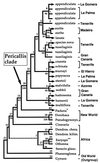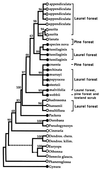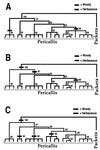Molecular evidence for multiple origins of woodiness and a new world biogeographic connection of the Macaronesian island endemic Pericallis (Asteraceae: senecioneae)
- PMID: 10570168
- PMCID: PMC24160
- DOI: 10.1073/pnas.96.24.13886
Molecular evidence for multiple origins of woodiness and a new world biogeographic connection of the Macaronesian island endemic Pericallis (Asteraceae: senecioneae)
Abstract
The prevalence of woody species in oceanic islands has attracted the attention of evolutionary biologists for more than a century. We used a phylogeny based on sequences of the internal-transcribed spacer region of nuclear ribosomal DNA to trace the evolution of woodiness in Pericallis (Asteraceae: Senecioneae), a genus endemic to the Macaronesian archipelagos of the Azores, Madeira, and Canaries. Our results show that woodiness in Pericallis originated independently at least twice in these islands, further weakening some previous hypotheses concerning the value of this character for tracing the continental ancestry of island endemics. The same data suggest that the origin of woodiness is correlated with ecological shifts from open to species-rich habitats and that the ancestor of Pericallis was an herbaceous species adapted to marginal habitats of the laurel forest. Our results also support Pericallis as closely related to New World genera of the tribe Senecioneae.
Figures



References
-
- Carlquist S. Island Biology. New York: Columbia Univ. Press; 1974.
-
- Hemsley W B. In: Report of the Voyage of H. M. S. Challenger. Botany. Wyville-Thompson C, Murray J, editors. Vol. 1. London: Her Majesty Stationery Office; 1885. pp. 1–299.
-
- Aldridge A E. In: Plants and Islands. Bramwell D, editor. London: Academic; 1979. pp. 279–291.
-
- Wagner W L, Herbst D R, Sohmer S H. Manual of the Flowering Plants of Hawaii. Vol. 1. New York: Columbia Univ. Press; 1990.
-
- Stuessy T D, Marticorena C, Rodríguez R-R, Crawford D J, Silva O M. Aliso. 1992;13:297–307.
Publication types
MeSH terms
Substances
Associated data
- Actions
- Actions
- Actions
- Actions
- Actions
- Actions
- Actions
- Actions
- Actions
- Actions
- Actions
- Actions
- Actions
- Actions
- Actions
- Actions
- Actions
- Actions
- Actions
- Actions
- Actions
- Actions
- Actions
- Actions
- Actions
- Actions
- Actions
- Actions
- Actions
- Actions
LinkOut - more resources
Full Text Sources

